Raymarine eS Series, long live the glass bridge
On Monday Flir unveiled Raymarine’s eS Series, and shortly thereafter, extensive detail on the new 7-, 9-, and 12-inch multifunction displays went online. A cynic might say that the eS Series is simply a refresh of the existing eSeries with its similar HybridTouch mix of keypad and touchscreen controls. But that would ignore multiple hardware improvements plus the amazing evolution of Ray’s Lighthouse II operating software since the lower-case “e” MFDs entered the market in 2011. For instance, click the photo above bigger to better see the full support for Navionics, C-Map, and LightHouse cartography (discussed here recently). Also, not to be ignored is the glass bridge style, which makes sense in all its ramifications and is very much here to stay, I think…
This eS Series photo highlights the extensive IP (and analog) camera support that came to Lighthouse II last fall, as many as 10 IP cameras, according to the detailed specifications table. You can also see the new eS knob/joystick design, which is described as a “multifunction rotary controller” that “offers precise menu and cursor control.” Note how the design is neatly echoed in the bracket knobs. In fact, this may be the sharpest looking bracket mount I’ve seen, though glass bridge styling always seems to cry out for panel or even flush panel mounting, both of which are also possible.
Doesn’t the panel mounted eS12 above look right? What really struck me about this photo, though, is the jumble of styles, which is still pretty much the norm on even many new boats. Maybe I’m getting jaded, but the ST70 and AP70, which seemed quite handsome a few years ago, now look a bit clunky. Dare we predict new Raymarine instruments and autopilot controls that are blacker, flatter, squarer, and mostly glass surfaced? Many of the manufacturers are moving in that direction and I think it’s great. Note, for instance, how even displays from multiple manufacturers blend together on Gizmo’s fly bridge (as seen in the new header photo and in more detail here).
There’s a practical side to the glass bridge style, too. Touch control is easier, especially when command buttons are at the edge of the screen, if the display’s surface stays flat as it extends beyond the screen. But in my view “glass bridge” is more than a style, its advent inextricably mixed up with the trend toward MFDs that include ever more functions. The eS above, for instance, is displaying 3 types of sonar, some of which may be built into the unit, and that’s not unusual in this “glass” age. There were actually 7 eS models introduced, as each of the three sizes has an eSx7 version with 600W ClearPulse 50/200 kHz sonar built in and an eSx8 version with the CHIRP/DownVision sonar that uses Ray’s combo transducer. The 7th model is the eS75, which has no sonar but does sport an aggressive $1,100 retail price.
Raymarine is also being more aggressive about its support of (Empirbus) digital switching technology, which is so complementary to the sleek, highly integrated black glass helm concept. The photo above reminded me of a “test of concept” I saw last fall in Fort Lauderdale.
As I understand it, this particular Sea Ray is not in production (yet) but it did neatly illustrate how Ray/Empirbus digital switching could turn some complicated helm controls into something easy and even fun. Sorry for my poor photo, but if you click it bigger you’ll get a sense of how lighting, cockpit table height, tender lift and more are touch controlled. The moving parts are even usefully animated on screen, and note how few physical switches are left to clutter the dash. Plus, it’s telling that someone painted the silver bezel of that Ray a12 black. An eS12 will obviously work better in that spot, and eventually, an all-touch aS Series also seems obvious.
Personally, though, I like hybrid touch/knob glass bridge designs if you can reach the MFD easily — and remote keypads like the RMK-9 when you can’t — and I’m particularly looking forward to trying Ray’s new controller (which may happen soon). Even the current eSeries (and RMK-9) controller seems slightly more useful than Simrad’s NSS evo2 knob — because it can manage the cursor as well as menus and volume/gain type functions — so how did they improve it?
The bigger picture, though, is Raymarine endorsing the glass bridge style even for smaller MFDs (than the gS Series). Consider the eS along with the recently introduced Garmin 7600 Series and Furuno TZTouch2, and suddenly Simrad NSS evo2 has a lot of company. And while I may lack imagination, I can’t picture the glass bridge style fading quickly. In fact, I think helms like the one below will just get glassier. It’s like wearing black clothes in New York City; it’s just worked for a long time, and there’s no sign it will stop working anytime soon.


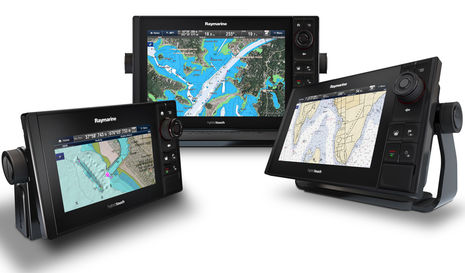
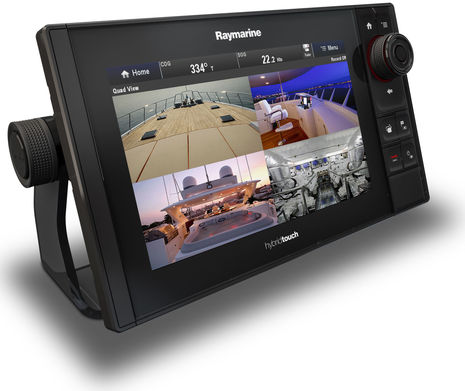
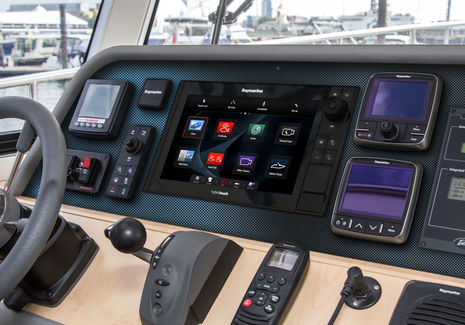

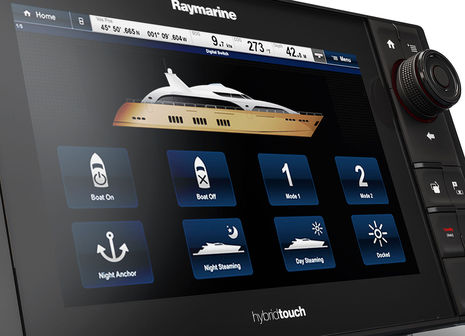
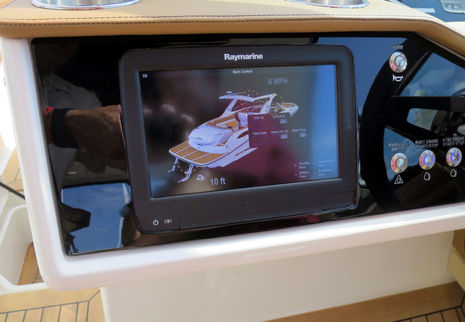
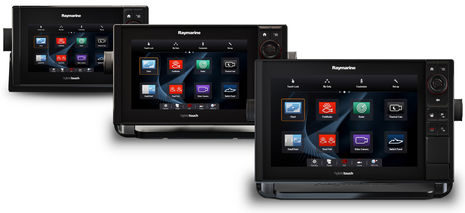
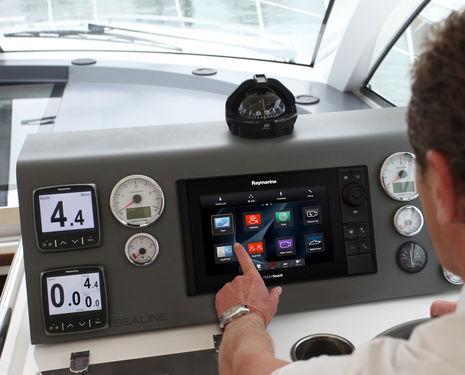

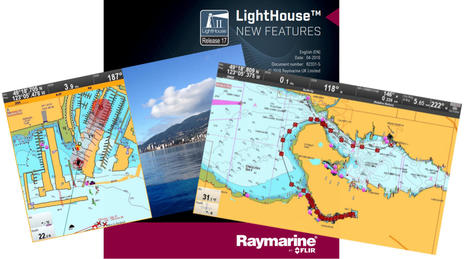

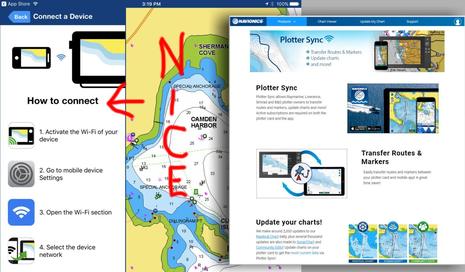







Nice, but why no sailing features like Garmin and B&G.
Ugh, I just bought an e125 three weeks ago to replace my e80.
Compared to Simrad NSS Evo2 and Garmin 7600xsv Raymarine eS is lacking support for Airmar CHIRP transducers and side scanning without external modules. And Raymarine don’t have a reasonably priced CHIRP module with Airmar CHIRP transducer support like what Simrad and Garmin have. The only Raymarine CHIRP sounders with Airmar support are the high end dual channel CHIRP sounders CP470 and CP570. Since the only CHIRP transducers directly supported by eS are the combined Down Imaging and high Q-factor 2D transducers (CPT-100 and similar) the sounder performance is comparable with Lowrance Elite CHIRP and not NSS Evo2 or 7600xsv.
Thanks, Abbor, but I must add that the CP100/CPT120 combination I’m testing on Gizmo looks pretty good compared to the more powerful Airmar BM75 CHIRP transducer I can run direct to NSS evo2 or Garmin 741xsv. I’ve also been impressed with the performance of Ray’s SideVision that I’ve seen on two demo trips, though I don’t know if the transducer will ever be made in a thruhull version.
Most important, though, is that what you descibe is the situation now, not the future. Raymarine has built a heck of an MFD platform and development process in recent years and I wouldn’t count them out in any area of electronics.
That includes sailing features, too.
Ben,
Raymarine seems to have dropped inclusion of screen resolution specs as far as I can tell. Any idea about the resolution on these new ones?
Cheers
Don
For me, the brand is not even on my wish list until they add broadband, solid-state radar to the mix. That must be tied up in patents or licensing agreements for only a single manufacturer to offer it.
I’m surprised someone hasn’t introduced an interface box to make 4G compatible with other brands of MFDs…it would seem technically doable, but maybe not legally doable.
It looks like the Marine Industry is taking a page from the Home Automation industry. Instead of one control for every item in a house, heating, lights, locks, drapes, etc. they put it into one software interface that works on an tablet, phone or dedicated display.
Once you go down that path pure convenience keeps you there, also it will be great for monitoring your boat with the cameras when your away.
Geez, Don, I think the eS spec list is the most complete I’ve seen from any manufacturer, and I complimented them on it:
http://www.raymarine.com/view/?id=12164&collectionid=179&col=12166
You’ll see that the screens are all optically bonded multitouch with 1,250 nits of brightness and wide viewing angles. The 7 and 9 inch have 800 x 480 WVGA resolution, and the 12.1-inch is 1280 x 800 WVGA.
The spec list even has detail like the type of Bluetooth and profiles supported, which other manufacturers seem shy about for some reason.
Only spec I see missing is power usage and that’s “TBD”
Karl, the Raymarine HD radomes and SHD open array radars are very good in my experience.
Jim, I’ve been dabbling with home automation and have been surprised to learn that the marine world has a more pervasive standard for switching and simple monitoring data (NMEA 2000). The Internet connection is much harder, though, because boats move and the LAN to WAN link must always be wireless.
I agree with Karl. This product line refresh is very welcome but I’ll be holding off from Raymarine until they get solid state RADAR. FLIR makes FMCW and solid state RADAR systems for the military so I suspect the issue is other than one of intellectual property.
Correct, Saffy. Navico was clear from the start that they did not own FMCW intellectual property, but instead did a whole lot of work to make it hit a performance/price point that fit recreational boating. They also said that a key to Broadband/3G/4G radar is the availability at reasonable cost of certain solid state drivers because they’re used by other industries in high volume.
So, yes, FLIR has solid state radar (and so does Garmin), but the hard part is making it for recreational marine at a tolerable price.
Thanks Ben,
I probably stared right at it several times and didn’t see it….sigh
The FLIR FX camera is out, and I think it could be darn useful around a boat. Best review detail so far is at the Verge, though I think they missed the value of the cam’s versatility:
http://www.theverge.com/2015/4/7/8355123/flir-fx-security-camera-hands-on
Wouldn’t it be cool if they made it possible to live stream this camera to a Raymarine MFD network using WiFi?
I’ve had DragonFly which is using the CPT100 transducer and which is giving identical results as CP100 as well as the Raymarine MFD’s with built-in CHIRP sounders. I have Simrad NSS Evo2, Garmin 527xs Lowrance HDS Gen3 CHIRP sounders and TM150M, B75H, B175H-W and TM265LH CHIRP transducers. I also have Lowrance HST-WSBL and 83/200 kHz HDI transducers. CPT100 is comparable with HST-WSBL and HDI operated in CHIRP mode, not with Airmar CHIRP transducers. NSS Evo2 HDS Gen3 and 527xs are even with TM150M head and shoulders above CP100 in both resolution and sensitivity. For serious fishing there is no alternative to Airmar CHIRP transducers (and yes I’m of course aware Garmin GT50M and GT51M, but even these don’t seem to be able to match Airmar based on the first screen shots posted at THT)
Of course I’m describing the situation now when commenting how the eS series is comparing with the competition, some which have been on the market for over a year.
When a customer can make the sonar images look crystal clear and NOT have to monkey with a series of button pushes, then and only then will they look and be as easy to use as any of the Raymarine and their fully automatic systems are. To date, not a single person I know has ever felt their Navico system was easy to use! Conversely, I can’t count how many people remark to me how very easy their Raymarine systems are to use and notice immediately their is zero adjustments needed to crest amazing pictures. So, I’m not thinking a system must be an AIRMAR transducer to give brilliant results.